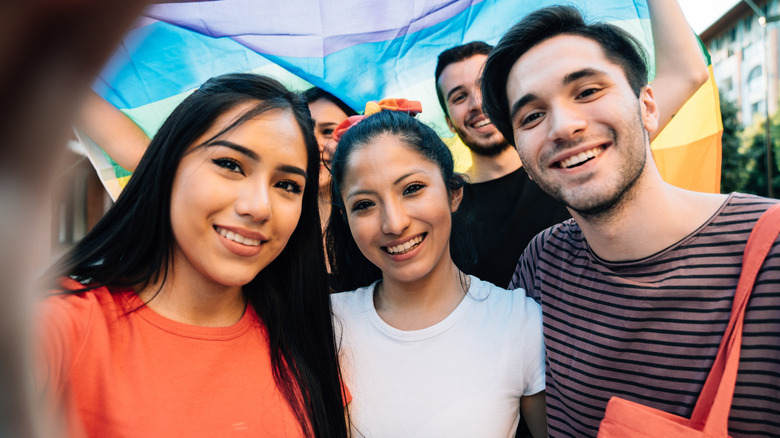Polyamory And Open Relationships Are Entirely Different Things, JSYK
Although we may not be aware of it, polyamory has been a part of our society and culture for centuries. It's only recently that we have seen more representation of polyamorous relationships on screen and in literature. Yet, this mode of representation does not always portray polyamory accurately. Polyamory is the capacity to and act of loving more than one person simultaneously, with respect and honest communication toward all parties involved. A 2021 study published in Frontiers in Psychology explains that non-monogamous relationships have become increasingly more common. The study's results found that almost one-fifth (16.8%) of participants have thought about being in a polyamorous relationship and 4-5% actually practiced polyamory. LGBTQ+ people were more likely to engage in polyamory.
There is often confusion around polyamory and open relationships. Many do not distinguish the two types of relationships, although they are entirely different things. We are here to set things straight and explain the differences between the two.
Polyamory is not only for straight men's pleasure
No, polyamory is not a straight couple looking for a third person, almost always a woman, to experiment with. A term was even created for this kind of woman, the unicorn, because it is so rare to find a single woman looking to join a straight couple in their experimental journey. While Urban Dictionary does not define unicorn as something negative, its implications seem more fetishizing than loving. This is especially the case given the countless straight men interested in being in a polyamorous relationship with multiple women. However, this is not to invalidate the very real polyamorous relationships between a man and two women who all love each other. The point we're trying to make is that polyamory is not solely centered around straight men's sexual fantasies.
Polyamorous relationships are rich in diversity. They are especially prevalent among certain groups within the LGBTQ+ community. Professor in the Department of Women, Gender and Sexuality at Harvard, Michael Bronski, told The Guardian that queer men have always engaged in more consensual non-monogamous relationships. However, Bronski explained that our society has 'consistently stigmatized their decision to do so'. Queer men's sexuality has long been shamed and even blamed for the HIV epidemic. It is time we stop perpetuating this false stigma and start embracing the diverse, polyamorous and open relationships we could all explore.
Polyamory vs. open relationships
Open relationships do not necessarily function on the basis of loving or being in love with multiple people at once. In most open relationships you have one primary romantic partner, but you are allowed to sexually explore other connections. You are still committed to one person, while you both seek out different sexual and sometimes romantic partners. Open relationships as well as polyamorous ones all fall within the umbrella term of ethical non-monogamy (ENM). Ethical non-monogamy is about trusting your partner and continuously practicing honest communication. While both types of relationships fall under ethical non-monogamy, polyamory is much more focused on the emotional aspect of the relationship. Polyamory is truly about romantically connecting with others, whereas open relationships often have a casual, sexual nature to them. Remember to always use protection when sleeping with other people. No matter what the other sexual partner says, it's vital to always prioritize your sexual health.
Breaking the stigma
Unlike open relationships, being polyamorous can become part of someone's identity. While the term polyamory is new, the practice of it isn't. The poly community has vibrantly existed for a while. There are multiple styles of polyamory, all founded on honesty and open communication between all partners involved. It is also important not to confuse polyamory with polygamy. Polygamy is the practice of marrying more than one person and does not necessarily relate to loving multiple people at once.
The key difference between polyamory and an open relationship is the level of commitment. Open relationships tend to be more casual, seeking an intimate connection with others while maintaining one primary partner. However, in polyamorous relationships, people experience love and romantic feelings for many partners. Sex can be an aspect of it, but it is not the main focus. Nevertheless, one thing both polyamory and open relationships have in common is the stigma they face. Non-monogamous relationships are often deemed as less-than, simply because they don't adhere to our forcefully monogamous, heteronormative society. However, there is beauty in finding what works best for you, whether that is through an open relationship or polyamory.



